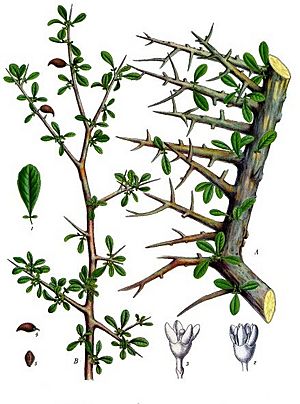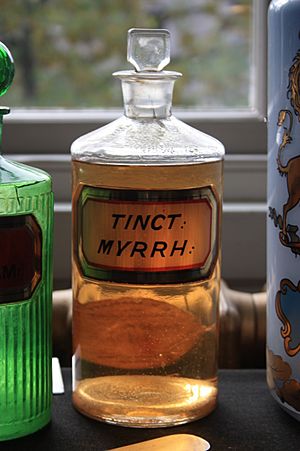Myrrh facts for kids
Myrrh is a special kind of sticky sap, called a gum-resin. It comes from small, thorny trees in the Commiphora family. People have used myrrh for thousands of years as a sweet-smelling perfume, a type of incense, and even as a medicine. In ancient times, myrrh was often mixed with drinks like wine. It was used for enjoyment and to help with pain.
Contents
How Myrrh is Collected
When a tree gets a cut or wound that goes through its bark and into the wood, it releases a sticky substance called resin. Myrrh gum is one of these resins, much like frankincense. To collect myrrh, people make small cuts on the trees. The tree then "bleeds" the gum, which is waxy and quickly becomes solid.
After it's collected, the gum turns hard and shiny. It starts as yellowish and can be clear or cloudy. As it gets older, it becomes much darker, and sometimes white lines appear in it.
The most common tree for harvesting myrrh is called Commiphora myrrha. Another name, Commiphora molmol, is actually the same tree.
Commiphora myrrha trees grow naturally in places like Somalia, Oman, Yemen, Eritrea, parts of Ethiopia, and Saudi Arabia. Myrrh from Arabia, known as Meetiga, is more crumbly and sticky than the myrrh from Somalia. It also doesn't have the white marks found in Somali myrrh.
Long ago, there was a special liquid myrrh called stacte. It was a key ingredient in holy incense used by Jewish people. This type of myrrh was very valuable, but we can't find it in markets today.
The Meaning of the Word "Myrrh"
The word "myrrh" comes from an old group of languages called Semitic languages. In these languages, the root word "m-r-r" means "bitter." For example, in Arabic, the word for bitter is murr.
The name "myrrh" came into the English language from the Hebrew Bible. There, it is called mor. Later, the word was used in Ancient Greek myths, like the story of Myrrha. In Greek, a similar word, múron, became a general term for any perfume.
Myrrh's Use in Medicine
In medicine, myrrh is used as an antiseptic. This means it helps stop germs. You can find it in mouthwashes, gargles, and toothpastes. It's also used in some creams and salves that you put on cuts and other small skin problems. Myrrh has been used to help with toothaches and can be rubbed on bruises, aches, and sprains.
Some people believe myrrh gum can help with indigestion, ulcers, colds, coughs, asthma, lung problems, arthritis pain, and even cancer.
Myrrh in Religious Traditions
Ancient Egypt and Punt
About 4,500 years ago, an Egyptian ruler named Sahure sent an expedition to a land called Punt, which is now part of the Horn of Africa, especially Somalia. They brought back lots of myrrh, frankincense, and other valuable items. King Sahure was so proud that a carving in his temple shows him planting a myrrh tree in his palace garden. This is the only Egyptian artwork showing a king gardening!
The ancient Egyptians also used myrrh, along with a salt called natron, to prepare mummies.
In the Hebrew Bible
Myrrh is mentioned as a special perfume in several parts of the Hebrew Bible. In the book of Genesis, traders carrying myrrh bought Joseph from his brothers. In Exodus, God told Moses to use myrrh as a main ingredient for a holy anointing oil.
Myrrh was also part of Ketoret, a special incense used in the First Temple and Second Temple in Jerusalem. This incense was offered on a special altar as an important part of the temple service. Myrrh was also used in the holy oil to anoint the tabernacle, high priests, and kings.
In the book of Esther, myrrh oil was used in a purification ritual for women who were to become queen. They spent six months with myrrh oil as part of their preparation.
In Ancient Nabataea
About 2,000 years ago, a historian named Diodorus Siculus wrote that myrrh was traded by the Nabateans. They carried it by land in caravans and by sea from Southern Arabia to their capital city, Petra. From Petra, myrrh was then sent all over the Mediterranean region.
In the New Testament
Myrrh is mentioned in the New Testament as one of the three gifts that the wise men brought to the baby Jesus. The other gifts were gold and frankincense.
Myrrh was also present when Jesus died and was buried. At his crucifixion, Jesus was offered wine mixed with myrrh. According to the Gospel of John, Nicodemus and Joseph of Arimathea brought a large amount of myrrh and aloes to wrap Jesus' body for burial.
In Christianity Today
Because it's mentioned in the New Testament, myrrh is still used as an incense during some Christian church services. Liquid myrrh is sometimes added to paint when making icons. Myrrh is often mixed with frankincense and other scents. It is used in the Eastern Orthodox, Oriental Orthodox, traditional Roman Catholic, and Anglican churches.
Myrrh is also used to make a special oil called chrism. Many churches use this oil for important ceremonies. In the Middle East, the Eastern Orthodox Church uses oil with myrrh and other fragrances for a ceremony called chrismation, which is sometimes called "receiving the Chrism."
In Islam
In Islamic traditions, the hadith (sayings of Muhammad) mention myrrh. One hadith says that Muhammad told people to "Fumigate your houses with mugwort, myrrh and thyme." This shows that myrrh was used for its scent and possibly for its cleansing properties.
Categories
See also
 In Spanish: Mirra para niños
In Spanish: Mirra para niños





